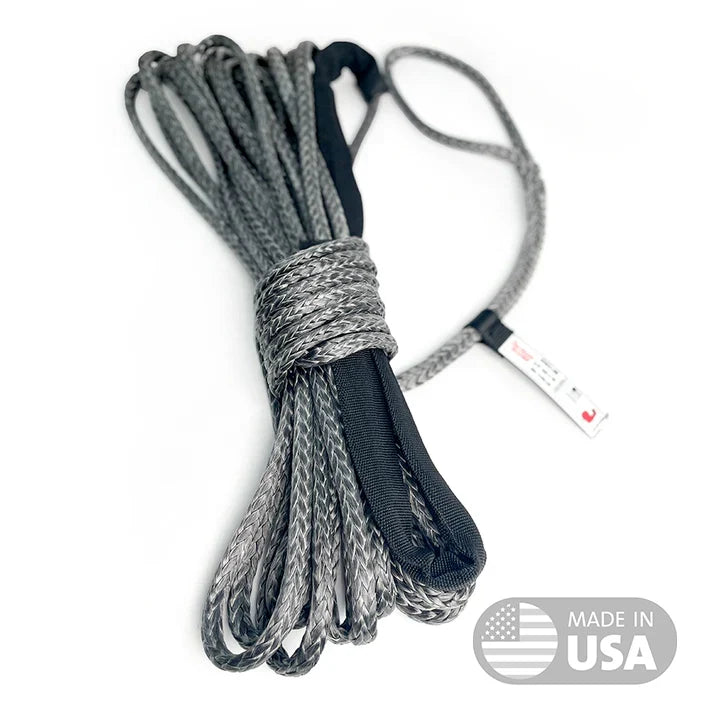
Everything to Know About Synthetic Winch Line
Share

Let's talk about winch lines! We all know a winch can sure come in handy when you or a buddy is stuck in the mud or caught in a pickle. And when it comes to winch lines, you've got options, but how do you know which is best for you?
Sure, the classic steel winch line has been around since the dawn of time. But synthetic winch lines are quickly becoming the cool kid on the block. They're strong, lightweight, and easier to handle than their steel counterpart. So, it's time to give them the recognition they deserve.
In this blog post, we'll give you the lowdown on everything you need to know about synthetic winch lines. How to repair them, maintain them, and when it's time to say goodbye and get a new one. So buckle up, grab your favorite beverage, and let's get to it!
When Did Synthetic Winch Line Get Made?
Synthetic winch lines have been around since the early 1990s. However, it wasn't until recently that they became widely adopted. Synthetic winch lines were initially used in the sailing industry because of their excellent strength-to-weight ratio and resistance to UV rays, saltwater, and abrasion. Later, they were introduced to the off-road industry and have become increasingly popular due to their advantages over steel winch lines.
Synthetic Winch Line vs. Steel Winch Line
The main advantage of synthetic winch lines over steel winch lines is their strength-to-weight ratio. A 3/8" synthetic winch line has roughly the same strength as a 3/8" steel winch line but weighs significantly less. This weight reduction can make a significant difference in the performance of your winch, as the lighter line puts less strain on your winch motor, allowing it to operate more efficiently. Additionally, synthetic winch lines are easier to handle, safer to use, and won't rust. Synthetic winch lines pair well with our Groove Fairlead.
Check out this video of Flawed Offroad upgrading his winch line and fairlead:
How Long Does Synthetic Winch Line Last?
The lifespan of a synthetic winch line depends on how frequently you use it and how well you maintain it. If you use your winch line regularly, you should inspect it after every use and replace it every two to three years. If you use your winch line less frequently, you should inspect it annually and replace it every five years. Remember, UV rays can degrade synthetic winch lines over time, so avoid leaving them exposed to sunlight for extended periods.
Synthetic Winch Line Maintenance
Maintaining your synthetic winch line is relatively straightforward. You should always keep it clean and free of dirt, debris, and mud. If it becomes dirty or muddy, you can clean it with soap and water or a synthetic winch line cleaner. Additionally, you should inspect your winch line after each use for any signs of damage, such as fraying, cuts, or abrasions. If you notice any damage, you should replace the line before using it again.
How to Repair a Synthetic Winch Line
If your synthetic winch line becomes damaged, you can repair it in most cases. To repair a synthetic winch line, you'll need a fid or splicing tool, a heat gun, and some synthetic winch line rope. First, cut off the damaged section of the winch line, leaving enough room to splice the new rope. Then, splice the new rope onto the old rope, ensuring that the new splice is tight and secure. Finally, use a heat gun to melt the synthetic fibers together, sealing the splice.
How to Remove Hook from Synthetic Winch Line
Removing the hook from a synthetic winch line is relatively easy. First, locate the locking pin on the hook and remove it. Next, slide the hook off of the winch line. If the hook is stuck, you can use pliers to twist it back and forth gently until it loosens. In some cases a hook must be cut from a winch line, there are three ways to fix this, either cut the hook or cut the winch line or untie the locking brummel loop. We have an excellent video tutorial for re-tying your locking brummel splice. Check it out below!
Best Synthetic Winch Line
Choosing the best synthetic winch line depends on your vehicle, specific needs, and budget. There are many high-quality synthetic winch lines available on the market, but here are some reasons to consider picking up a Yankum Ropes synthetic winch line:
- Lightweight and easy to handle
- Made from high-strength HMPE fiber, giving it higher breaking strength than steel
- Comes with a chafing sleeve to protect the line from chaffing on abrasive obstacles
- Made in the USA in an ISO 9001:2008 certified facility
Get Your Own Synthetic Winch Line Today
In conclusion, synthetic winch lines are an excellent option for off-roaders due to their lightweight, strength, and ease of use. However, like any recovery tool, synthetic winch lines require proper maintenance, inspection, and replacement to ensure optimal performance and safety. If you're in the market for a synthetic winch line, consider picking up a Yankum Ropes Winch Line today!



